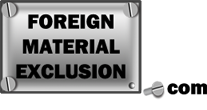Usually the first step in Foreign Material Exclusion is to set up a zone where material will be controlled. In high rise construction that zone is anywhere that is elevated. In engine or turbine manufacturing that zone is set up around an open engine. Depending on zone size and location, different methods will be used to set up the zone. In any case the zones are distinguished and identified by barricades.
One-person jobs that are very brief in nature may only require a single sign as a friendly reminder to use proper preventative equipment for the particular job. Signage should fit the overall color scheme of other FME projects and should have no clear plastics as a part of the assembly. Having tinted or colored material prevents losing hard to find pieces in the unfortunate event that the signage is broken. The best signage has the benefit of reusability in different situations through the use of interchangeable inserts.
Barricade tape provides a boundary where signage alone simply isn’t enough. It is good way to temporarily block access to a site that will only be worked on for a short period of time. Workspaces that are larger than a few feet can be identified effectively with barricade tape. The barrier or barricade tape should fit the color scheme and clearly mark the boundaries of the FME Zone. Text such as “FME Barrier” works well. Signage should be included at intervals around the barrier to indicate that the area is being protected from debris.
A barrier for an area that is located in a central area with little visual or physical separation from the surrounding elements requires a lot of barrier creation. In addition to clear signage and barrier tape, the zoned area may also require stanchion setup. Stanchions are great barriers for longer term work, when simple barricade tape may not last as long as the job itself. Again, signage should supplement the stanchion barrier.
Some FME jobs employ the use of Lexan Sheeting and/or debris netting to ensure proper foreign material protection. They are for more specialized application such as permanent handrail protection, or to protect openings from falling objects. Both of these should be considered when determining the nature of the work being done. Remember to look for tinted and colored material.


 Use our lanyard selection form and we'll help you get the right lanyards for the job.
Use our lanyard selection form and we'll help you get the right lanyards for the job.